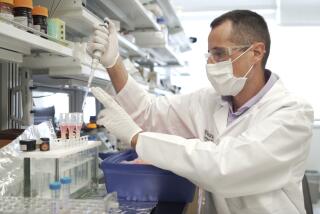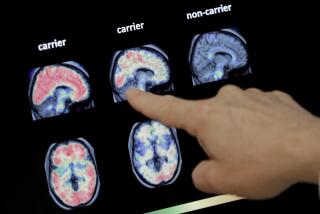With millions more expected to develop Alzheimer’s, more research funding demanded
- Share via
Over the next 35 years, about 28 million baby boomers will likely develop Alzheimer’s disease, and the annual bill for their care will balloon from $11.9 billion in 2020 to more than $328 billion in 2040, says an analysis released Monday.
Barring the discovery of treatment that could delay or prevent the onset of Alzheimer’s disease, the cost of caring for baby boomers with the disorder by 2040 will eat up a quarter of the nation’s total Medicare spending, researchers have estimated.
That figure greatly underestimates the true cost of caring for those with Alzheimer’s since it does not include out-of-pocket expenses, home care and long-term care insurance payouts, said Maria C. Carillo, chief science officer of the Alzheimer’s Assn.
The new projections were presented in Washington, D.C., on Monday at the 2015 Alzheimer’s Assn. International Conference. The estimates come from an Alzheimer’s Assn. model of the disease’s incidence, prevalence and cost of care.
The estimates were used Monday to sound a clarion call for more research funding aimed at finding ways to prevent, delay and treat the disease that progressively robs patients of their memory and their ability to function.
Despite high stakes, candidate-medications on which patients and scientists alike have pinned their hopes have proved ineffective at disrupting or reversing the disease process. Those include wide-ranging efforts to develop drugs that reduce the accumulation amyloid plaques in the brain -- a hallmark of Alzheimer’s disease. Researchers in Washington this week are to hear the results of new trials of genetically-engineered therapies that take that approach. But they also will learn whether experimental drugs representing two new approaches to treatment have proved promising in clinical trials.
The escalation of the disease comes as baby boomers -- a generation of 76.4 million Americans born between 1946 and 1964 -- turn 65 at a rate of roughly 10,000 a day.
“The risk of Alzheimer’s increases with age, and as baby boomers get older, the number of people developing the disease will rise to levels far beyond anything we’ve ever seen before,” said Keith Fargo, the Alzheimer’s Assn.’s director of scientific programs and outreach.
Next year, the oldest baby boomers will begin turning 70 -- an age at which new diagnoses of Alzheimer’s jump from less than 1% (among those 65 to 69) to 2.5% (among those 70 to 74). By the year 2050, just over half of baby boomers will be 85 or older, and many with Alzheimer’s will have progressed to the disease’s most debilitating stages. The cost of care will rise accordingly, the new estimates predict.
Fargo lauded the work of researchers and scientists exploring several promising new approaches to thwarting Alzheimer’s. But “Alzheimer’s is extremely underfunded compared to the magnitude of the problem,” he warned in a speech delivered to researchers and clinicians gathered in the nation’s capital.
“If we’re going to change the current trajectory of the disease, we need consistent and meaningful investments in research from the federal government to ensure a more robust pipeline,” Fargo said. Treatments that have driven down rates of heart disease, cancer and HIV/AIDS infection have benefited from the steady commitment of federal funds, Fargo said.
“Now is the time to do the same for Alzheimer’s disease,” he added.
The National Institutes of Health are expected to spend $586 million in this fiscal year on Alzheimer’s research, and the Obama administration has proposed a $638-million budget for fiscal year 2016. But the planned upward trajectory of spending on Alzheimer’s must still make its way through Congress.
The escalating impact of this dementia could be blunted even by therapies that merely delay the onset of Alzheimer’s. An Alzheimer’s Assn. report released earlier this year estimated that if some therapy were able to delay the average onset of Alzheimer’s by five years, the number of people who have the disease in 2050 could drop from 13.5 million to 7.8 million.
The resulting savings could amount to $220 billion over the first five years that such a therapy were in wide use.
Follow me on Twitter @LATMelissaHealy and “like” Los Angeles Times Science & Health on Facebook.







